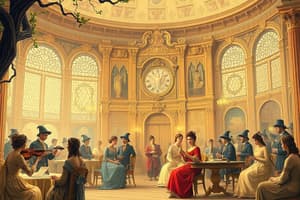Podcast
Questions and Answers
What is the primary function of the elements of music?
What is the primary function of the elements of music?
- To transform ordinary sounds into music (correct)
- To define musical styles
- To create musical instruments
- To create musical genres
Where do we NOT typically perform or listen to music?
Where do we NOT typically perform or listen to music?
- On the radio
- In a library (correct)
- In the car
- In a restaurant
What is the term for the sensory effect of sound on the ear?
What is the term for the sensory effect of sound on the ear?
- Pitch
- Sound (correct)
- Melody
- Timbre
What is the term for how high or low a musical tone is?
What is the term for how high or low a musical tone is?
What is music?
What is music?
What is NOT one of the uses of music?
What is NOT one of the uses of music?
Is there a society without music?
Is there a society without music?
What is NOT an example of where we typically listen to and/or perform music?
What is NOT an example of where we typically listen to and/or perform music?
What determines the pitch of a sound?
What determines the pitch of a sound?
What is melody in music?
What is melody in music?
What is harmony in music?
What is harmony in music?
What is rhythm in music?
What is rhythm in music?
What is tone color/timbre in music?
What is tone color/timbre in music?
What is texture in music?
What is texture in music?
What determines the texture of a piece of music?
What determines the texture of a piece of music?
What are semibreve, minim, crotchet, quaver, semi-quaver, and demi-semi-quaver examples of?
What are semibreve, minim, crotchet, quaver, semi-quaver, and demi-semi-quaver examples of?
Flashcards are hidden until you start studying
Study Notes
Understanding Music
- Music is the art of arranging sounds in time to produce a composition through elements like melody, harmony, rhythm, timbre, etc.
- Music is a universal cultural aspect of all human societies, combining vocal or instrumental sounds for beauty or emotional expression.
Where Music is Experienced
- Music is present throughout our life cycle, from birth to death.
- We experience music in various settings, such as:
- Cars
- Restaurants and cafeterias
- Radio and television
- Movies
- Theatres and concert halls
- Churches
- Barbering shops
Uses of Music
- Music serves various purposes, including:
- Entertainment
- Relaxation
- Worship
- Inspiration
- Consolation
Elements of Music
- The special features that transform ordinary sounds into music are:
- Sound
- Pitch
- Melody
- Harmony
- Rhythm
- Tone color (timbre)
- Texture
- Dynamics
Sound
- Sound is a particular auditory impression produced by vibration or mechanical radiant energy.
- It is transmitted by longitudinal pressure waves in a material medium, such as air.
Pitch
- Pitch refers to how high or low a musical tone is.
- The frequency of vibration determines the pitch of a sound, with faster frequencies producing higher pitches and slower frequencies producing lower pitches.
Melody
- Melody is a rhythmic succession of single tones organized as an aesthetic whole.
- It is the part that impinges on the mind when a four-part choir sings a hymn.
Harmony
- Harmony refers to the co-occurrence of two or more independent voices sung or played at a time.
- It involves creating a blend of different parts, like when you try to create your own part to harmonize with a familiar melody.
Rhythm
- Rhythm is the result of combining short and long durations of pitches/notes in music.
- It is represented by notational symbols for duration, such as semibreve, minim, crotchet, quaver, semi-quaver, and demi-semi-quaver.
Tone Color/Timbre
- Tone color or timbre is the quality of sound associated with a musical instrument.
- It enables us to distinguish one instrument from another, even if the melodies are the same.
Texture
- Texture refers to how light or dense a piece of music is, depending on the manner in which different musical instruments come to play.
- The fewer the musical instruments, the lighter the texture, and vice versa.
Studying That Suits You
Use AI to generate personalized quizzes and flashcards to suit your learning preferences.




